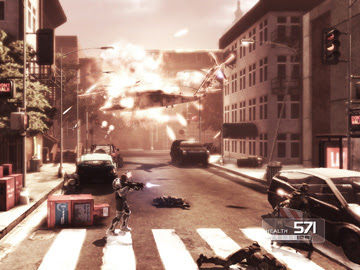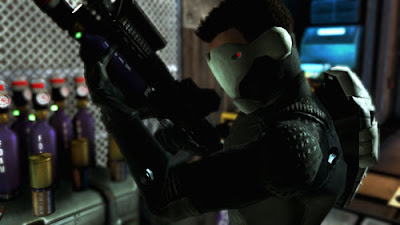MIXED BAG PRESENTS
SHADOW COMPLEX REVIEW!
Developer: Chair Entertainment, Epic Games
System: XBOX 360 (2009)
Genre: Side-Scrolling Platformer/Action/Adventure
I think many of you reading this review will have no idea what Shadow Complex is or had forgotten until you read the header of this article. If you bought it and played it, you'll probably also remember that the game was actually a big deal when it hit Xbox Live's marketplace in the Summer of 2009. The game sold 200, 000 copies in its first week on Xbox Live at a $15 price point. It was shown off at that year's E3 by Cliff "Cliffy B." Bleszinski (of Epic Games and Gears of War fame) during the Microsoft Press Conference. Its success would seem to point to a sequel that probably would've been even bigger and improved upon its formula. Except, three years later, and the latest news I can find about a potential sequel is that the game is in development Limbo and, according to Mr. Bleszinski it is largely designed and just sitting somwhere.
I have my own theory as to why we haven't seen a sequel yet (and may never get one), but before you see that later in the review, let's get started.
STORY
Well, I hate to say it, but if this game has any sort of weakness... its the story. There is a novel, or duet of novels, by Orson Scott Card (sci-fi author of Ender's Game) that were licensed to run parallel to the game(s). The story doesn't really inspire anything, but "this is pretty generic" from its audience and I think the lame story/lack of atmosphere is the reason this game is all but forgotten. The basic plot, as much can be mustered with the help of a wikipedia article since the game doesn't do a fantastic job at telling its fairly shallow story, is as follows:The game begins with you playing a fully powered agent with armor trying to save the Vice President from assassination before the villain, Lucius, shuts down your suit. Scene transition to Jason Fleming (voiced by Nolan North (Desmond Miles from Assassin's Cred and Nathan Drake from Uncharted)) and his new girlfriend Claire (voiced by Eliza Jane Schneider (Rebecca Crane from Assassin's Creed and about half of the female cast of South Park ex. Wendy, Sharon, Ms. Crabtree etc.) are hiking to explore some caverns that Claire found as a child. It quickly turns out that the caves make up a paramilitary terrorist organization's base of operations for a planned invasion of San Francisco that is to be the basis of a 2nd Civil War in America. Claire is kidnapped and you spend the rest of the game gathering armor and weapons to traverse the facility killing faceless, nameless, and practically without motive bad guys in order to save Claire and escape.
There really isn't much more to it than that, I'm afraid. So, how does the game recover from having such a shallow and, worst of all, uninteresting story?
PRESENTATION
The game springs back from dullness thanks to the sweet and successful blend of 3-D graphics into a 2-D sidescroller that manages to update the formula of classic games like Super Metroid (Super Nintendo, 1994) and Castlevania: Symphony of the Night (PS1, 1997). I don't think the design elements are quite as refined, but it has its own charm and I'm sure its sequel could've brought an even more attractive experience to the arcade platform. First, lets start by talking about the graphics a little bit.The game has you traipsing around in three types of environments: first, a forested mountain environment, then the shadow-heavy caverns and tunnels, and, last and usually most disliked environment, water segments (luckily few and far in between and short). The problem is that, while well designed, it doesn't stand out. The design choices are similar to many near future sci-fi schooters that have been made before and since Shadow Complex-- with generic black, red, and white wearing bad guys (that is the general color scheme of the game) and giant silver robots. They could've done more characterize the enemies and give the game a sense of atmosphere that would be worth going on and on about. They do a good job of making things pretty articulate on the screen, especially with the use of color coordination that is extremely reminiscent of the color coding of doors from Super Metroid.
The music isn't nothing to write home about either, but the sound design is solid and helps a lot in giving the gameplay a satisfying weight. When you hit an opponent with a melee move, the solid thumps and crunches are well-timed, and when an opponent screams out just as he has been blown up or punched across a room is one of the game's best rewards. The thing about Shadow Complex is that many of its elements feel generic, but are still effective, and ultimately, it creates a fun experience thanks to...
GAMEPLAY
If there is anything that sold me on Shadow Complex, it is the gameplay, holy crap is it the gameplay-- I've played Symphony of the Night (loved it) and Super Metroid (I still need to finish it...got stuck) yet, in terms of game play of this genre, Shadow Complex is KING. The general formula of this type of game is exploration, puzzle-solving, platforming, combat, and story. While it fails in that final respect, it demolishes in the other four categories.The puzzle-solving comes in the way of the various upgrades and weapons you find in the game that combines the old Metroid formula with some more creative physics only possible in this sorta next gen game. The hookshot, missiles, grenades, and weapon upgrades are pretty standard, but two upgrades stand out: first, the foam, which can be used to slow or freeze enemies temporarily, destroy turbines, and create temporary platforms on walls, floors, and ceilings. And the other upgrade, the running upgrade, is probably one of the best elements of the games because it can be used to solve puzzles and improves the platforming.
The platforming manages to take the simulated speed of Sonic (who, actually, is slower than Mario in many of his games), because it allows you to run up walls and on ceilings, destroying objects and enemies in your path, that makes you feel uber powerful. The other element of the platforming is how it allows to traverse the shadow complex; the controls for the platforming is superb and make you feel like a ninja when you sneak past, around, and up behind enemies to defeat them with your mind or your might.
The combat, by the way, is the best element of the game. While the gun controls are not always perfect, as when you try to shoot enemies in the background there can be some problems, it is still satisfying to shoot the baddies in this game. Even more satisfying, as mentioned earlier, is how great it feels to pull of a melee attack. You can even kick little robots like a football! Eventually, your armor allows you to punch guys across a room! This makes backtracking and gathering XP a lot less irritating by giving you the opportunity to get better and better at beating the baddies.
PROS VS. CONS
- The story and most of the design elements are all adequate, but also so terribly generic that this game has been all but forgotten. They're fine, but also kinda boring.+ The exploration can be a bit back-tracky, but is redeemed through rewarding player's exploration with useful collectables and enemies that are fun to beat.
+The puzzle-solving is taken right out of Super Metroid, if not a little less obtuse, but effectively help the pacing of the game and encourage exploration.
+ The platforming is a mix between Super Metroid and Sonic the Hedgehog. Its all about fast-paced shooting and melee attacks.
+ The combat is what pulls this game together and, ultimately, allows the experience to transcend its otherwise generic feel.
CONCLUSION?
4/5.
For $15, there are few games on Xbox Live Arcade that I would recommend before this throwback to side-scrolling adventure games of the 90's. Yes, it can feel pretty generic at times, but it pulls through with enjoyable gameplay that will make it at least worth a purchase and play, if not a couple more if you love the gameplay as much as I do, and I hope there is a sequel in the future (I think there might not be because of a mix of the controversial association is has with Orson Scott Card (who's political agenda has overshadowed much of his work in recent years) and/or, more likely, some sort of licensing issues).Anywho, if you like Symphony of the Night and Super Metroid, you'll definitely want to check out Shadow Complex on the Xbox 360.













